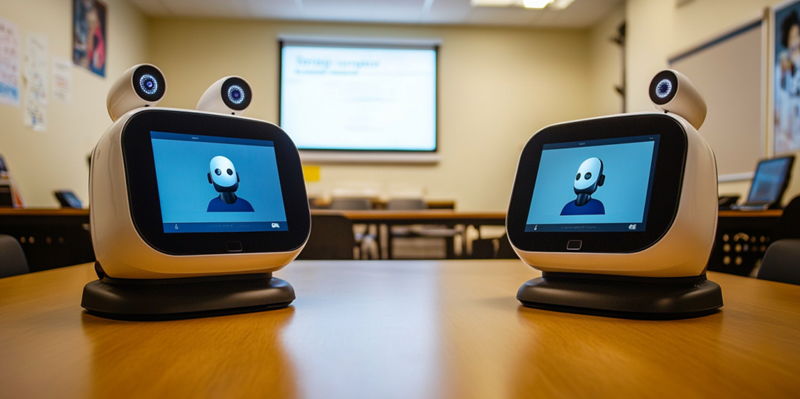As the UK grapples with the persistent issue of school absences, an innovative proposal on the horizon aims to harness technology to address this challenge head-on. Telepresence robots, particularly the AV1 robots developed by Oslo-based company No Isolation, are being recommended following promising results from a pilot project in Wirral, northern England. During the trial, school attendance among participants surged by 21%, while engagement in learning activities increased by an impressive 42%, demonstrating the potential of such advanced technologies to make a significant difference. With the rise in school absences since the COVID-19 pandemic, especially severe absences where students miss at least half of school sessions, advocacy groups like Child of the North and the Centre for Young Lives are championing this high-tech solution.
The AV1 robot offers a novel approach by placing the device in a student’s classroom seat, allowing the student to attend virtually from a safe space such as their home. This setup enables students to maintain a connection with their school environment and participate in real-time classes, facilitating a gradual reintegration process. Current measures to combat school absence often involve punitive actions such as fines for parents, which have shown limited effectiveness. Anne Longfield, the executive chair of the Centre for Young Lives, emphasizes the need for tailored interventions, as a blanket approach cannot address the diverse circumstances causing students to miss school. The shift toward more innovative and flexible methods, like the use of telepresence robots, marks a progressive step in dealing with this complex issue.
The Need for Innovative Solutions
Advocacy groups behind this initiative stress that the UK government’s traditional punitive responses to truancy need reevaluation. The report highlights that simply penalizing parents does not adequately address the underlying issues that keep children away from school. Recent statistics reveal shockingly high rates of severe absences, which significantly threaten the academic future, safety, and overall development of affected children. By exploring more supportive methods, such as the implementation of telepresence robots, the initiative aims to offer a proactive solution to this growing concern.
The AV1 robots exemplify a supportive method that extends beyond the punitive model. These robots can help children who, due to various health conditions or anxiety-related issues, are unable to attend school physically. By providing a means for these students to be present in the classroom virtually, the robots help maintain an essential link between the student and their educational experience. This approach not only supports the student academically but also psychologically, helping mitigate feelings of isolation and disengagement. The goal is to offer a nurturing alternative, which prevents the deterioration of students’ academic and social development caused by prolonged absences.
The Role of Telepresence in Reintegration
Introducing telepresence robots into the educational setting aims to foster long-term engagement and reintegration into traditional classroom environments. Reintegration is a gradual process that requires consistent support, which telepresence facilitates by keeping students involved in daily classroom activities and interactions. These robots act as a bridge, allowing students to transition back into the classroom at a pace suitable to their needs, helping to build their confidence and mitigate anxiety associated with stepping back into a school setting after prolonged absences.
Moreover, the underlying philosophy of using telepresence robots reflects a deeper understanding of the multifaceted reasons behind school absences. Instead of viewing absences purely through a lens of non-compliance or indiscipline, this strategy aligns with a compassionate perspective that considers mental health, physical health, and other socio-economic factors. By recognizing these varied challenges and addressing them with a flexible, student-centric solution, education stakeholders can work toward more holistic and effective engagement strategies. The AV1 robots, therefore, represent not just a technological innovation but a paradigm shift in how educational systems can support vulnerable students.
Conclusion
The UK is tackling ongoing school absences with an innovative solution that leverages technology. Telepresence robots, specifically the AV1 robots created by Oslo-based company No Isolation, are now being recommended after a successful pilot in Wirral, northern England. During this trial, student attendance rose by 21% and engagement in learning activities climbed by 42%, highlighting the technology’s potential to make a meaningful impact. Since the COVID-19 pandemic, there has been a notable increase in school absences, particularly severe cases where students miss at least half the school days. Groups like Child of the North and the Centre for Young Lives are advocating for this high-tech answer.
The AV1 robot provides a unique method by placing the robot in a student’s seat, enabling the student to attend class virtually from home. This allows for real-time participation in school activities, aiding in a smooth reintegration process. Traditional measures to curb absenteeism often involve penalties for parents, which have shown limited success. Anne Longfield, executive chair of the Centre for Young Lives, stresses the need for targeted interventions, arguing that a one-size-fits-all approach fails to address the varied reasons behind absences. The move toward flexible, innovative solutions like telepresence robots represents a positive stride in addressing this complex challenge.

